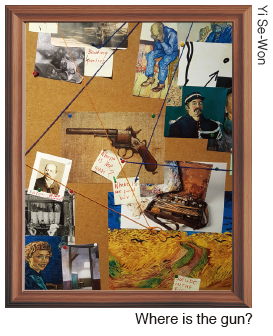“In the life of the painter death may perhaps not be the most difficult thing. For myself, I declare I don’t know anything about it. But the sight of the stars always makes me dream. Why, I say to myself, should the sparks of light in the firmament be inaccessible to us?”
- Vincent Van Gogh

The famous artist Vincent Van Gogh is the subject of a recent movie, Loving Vincent. In conjunction with this film, M Contemporary museum in Gangnam is currently holding an exhibition of Van Gogh’s works, also entitled Loving Vincent. These two events offered two writers from The UOS Times the opportunity to enjoy his life story in two different ways: the movie and the exhibition. Here is a dialogue between the two writers: “M,” who has recently watched the movie Loving Vincent, and “E,” who has recently visited the Loving Vincent exhibition.
M: The movie was also interesting, especially considering the fame of Van Gogh. All scenes are painted like an oil painting, and the loud colors were impressive. I heard that animators had tried hard to reproduce his painting style. It was successful, at least to me.
E: I feel it was successful, too. I could appreciate the scenes at the exhibition. The paintings used for the scenes were displayed in the first hall. Lines were simple, but the colors and tones were vivid. When I looked more closely, I noticed that the brush strokes were rough, yet they seemed smooth when I looked at them from a distance. The colors were definitely contrasting, but they looked harmonious. That was amazing. I briefly saw the story of the movie through those paintings. Isn’t it about the death of Van Gogh?
M: Yes, the movie is set during the year after his death. A man named Armand goes to deliver a letter from Van Gogh to Theodor Van Gogh, Vincent’s brother. Armand’s father is a postman, and he was kind to Van Gogh when he was alive, unlike other people in the town. Armand discovered that Theodor was already dead, so he left again to give the letter to Doctor Gachet, a close friend of Van Gogh. Van Gogh had shot himself, but he died two days later. On the day he shot himself, Doctor Gachet came to see him on his bed when he was bleeding.
E: There was a portrait of Doctor Gachet by Van Gogh. They were really close. Most of the characters are from Van Gogh’s real paintings. The postman was there, too. The self-portraits of 1887 drawn by Van Gogh were not actually of him. Did you know that? They were portraits of Theodor. He supported his brother through his drawings. They had exchanged letters, and now, all the drawings have been released in a book. I did remember I had read a part of the letter in high school for a class.

M: Their letters are the motif of the movie. Van Gogh told his paint seller, Tanguy, that he and Theodore were “two hearts, one mind.” Theodore Van Gogh believed and supported him. Van Gogh started painting at the age of 28, which wasn’t so young.
E: Then, why did he shoot himself? His death is actually doubtful. In the exhibition, there was a display about the mystery of his death called “Not to blame anyone.” He went out to paint, but he came back without his painting gear and with a mortal wound. He claimed that he had tried to commit suicide. No one knew why, and there wasn’t any suicide note. Isn’t it weird? The display included a graph showing possible reasons if it was suicide. Family problems, work, and money problems were three things that were guessed. But all these reasons have pros and cons. It is really a mystery.

M: I think it is not easy to be sure he shot himself. And the direction of the bullet didn’t look like a suicide. This clue is from the movie. The movie casts doubt on whether it was a suicide??through Armand, the main character. Doctor Gachet said that Van Gogh had depression, so he thought it was a suicide. But I feel Van Gogh had humanity in his relationship with his brother, and he put more weight on life than on art. He had such artistic expression, but he often talked about life in his letters.
E: It was unfortunate that he sold just one picture when he was alive. He was poor. In the exhibition, there were two pictures of Van Gogh, but those are his real paintings, and they are not famous, but they show his style perfectly. He suffered from depression. Surprisingly, I could not feel his depression from his pictures, but rather a warm and peaceful feeling came much more strongly. Maybe it was there, like the base note of a perfume. This is his genius, painting the darkness of life in vivid light.
M: Tanguy said “He felt everything. He felt too much. It made him want the impossible.” I think he really felt everything, even the depressing. This made him paint the color of light. Sensitivity can be a blessing to an artist. However, it can also destroy a man and his humanity. People in the town said he was a weirdo. We can see that he actually wasn’t through what Van Gogh himself said: “I want to touch people with my art. I want them to say: he feels deeply, he feels tenderly.” That was in the ending credits of the movie.

Yi Se-won
devel0ppe@uos.ac.kr
Kim Kyung-sun
kyungsun16@uos.ac.kr

